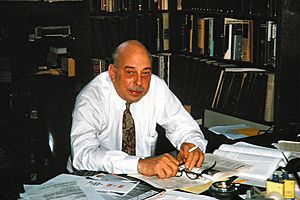Louis Fieser facts for kids
Quick facts for kids
Louis Frederick Fieser
|
|
|---|---|
 |
|
| Born | April 7, 1899 |
| Died | July 25, 1977 (aged 78) |
| Alma mater | Williams College Frankfurt University Harvard University |
| Known for | Synthesis of vitamin K Quinone Cortisone Woodward–Fieser rules |
| Spouse(s) | Mary Peters Fieser |
| Awards | George C. Pimentel (1967) William H. Nichols Medal (1963) |
| Scientific career | |
| Fields | Chemistry |
| Institutions | University of Oxford Harvard University |
| Thesis | Reduction potentials of quinones. / A new absorbent for oxygen in gas analysis (1924) |
| Doctoral advisor | James Bryant Conant |
| Doctoral students | Donald J. Cram William Summer Johnson Alfred Bader |
| Other notable students | Donald J. Cram |
Louis Frederick Fieser (born April 7, 1899 – died July 25, 1977) was an American organic chemist. He became a professor at Harvard University and later a professor emeritus. He is well-known for his important work in chemistry, including creating napalm for military use in 1942.
Fieser's research led to many discoveries. He was the first to create vitamin K in a lab, which helps blood clot. He also studied chemicals called quinones to fight malaria. His work with steroids helped create cortisone, a medicine used to reduce swelling. He also explored polycyclic aromatic hydrocarbons, which are complex chemical compounds.
Contents
Early Life and Education
Louis Fieser was born in Columbus, Ohio. He earned his first degree in chemistry from Williams College in 1920. Later, he received his PhD from Harvard University in 1924. His main research during this time was about measuring how easily certain chemicals, called quinones, could be oxidized.
After his PhD, Fieser continued his studies. He worked at the University of Oxford in England and at Frankfurt University in Germany. From 1925 to 1930, he taught at Bryn Mawr College. It was there that he met his future wife, Mary Peters. After Bryn Mawr, he joined the faculty at Harvard University.
Working with Mary Fieser
Louis Fieser worked closely with his wife, Mary Peters Fieser. She was also a talented chemist. Together, they wrote eight books on chemistry. They also started a famous series of books called Reagents for Organic Synthesis. Chemists often call these books "Fieser and Fieser." Louis Fieser also helped edit and contribute to another important chemistry publication, Organic Syntheses.
Teaching Chemistry
At Harvard, Professor Fieser was a very popular teacher. He used creative ways to help his students learn. For example, he once showed "How NOT to Perform a Recrystallization." During this demonstration, he let a flask of charcoal overflow, making a big mess on his desk and himself. This helped students understand what to avoid.
Fieser even made a special educational film for his organic chemistry classes. In one part, he showed how to get cholesterol from gallstones. The film featured a collection of very large and rare gallstones from hospitals. His students really liked his teaching style. They even sold orange "Louie" sweatshirts with his face on them in Harvard Square. Fieser himself wore one of these sweatshirts to a lecture one day!
Important Chemical Discoveries
Louis Fieser is known for several important contributions to chemistry. Two chemical mixtures are named after him. Fieser's reagent is a blend of chromium trioxide in acetic acid. Fieser's solution is a liquid mixture used to remove oxygen from gas.
He also helped develop the Woodward's rules, which are now called the Woodward-Fieser rules. These rules help chemists predict how certain chemicals will absorb ultraviolet light. Fieser was also the first to suggest that a unique chemical structure, called iceane, could exist.
Research on Vitamin K
In 1939, Fieser was part of an exciting scientific race. Many scientists were trying to figure out the exact structure of Vitamin K. This vitamin is very important for blood clotting. By the end of that year, Fieser was able to announce that he had successfully created Vitamin K in his lab.
His work was so important that he was considered for the Nobel Prize in Physiology or Medicine in 1941 and 1942. Although no prizes were given out in those years, the 1943 award went to other scientists for their work on Vitamin K.
Contributions During World War II
During World War II, Louis Fieser played a role in a military project. He helped develop napalm, a substance used to create fires. It was produced by Dow Chemical during the war.
One project, called Project X-ray, involved dropping bats with small incendiary charges over Japan. The idea was that the bats would nest in buildings, and then the charges would ignite, starting fires. During a test run, some bats escaped and accidentally set fire to buildings at Carlsbad Airfield, including hangars and barracks.
The use of napalm later became controversial during the Vietnam War. However, Fieser stood by his invention. He believed that his job was to create the chemical, not to judge how it was used. He famously said, "I have no right to judge the morality of Napalm just because I invented it."
Later Life and Legacy
In 1962, Fieser joined the U.S. Surgeon General's Advisory Committee. This committee released a famous report in 1964 about the link between smoking and health. After this, Fieser became an active supporter of the committee's findings, promoting healthy living.
Louis Fieser was also a mentor to many young chemists. One of his students, Donald J. Cram, later won the Nobel Prize in 1987. Fieser was elected to several important scientific groups, including the American Academy of Arts and Sciences in 1933 and the United States National Academy of Sciences in 1940.
Images for kids


